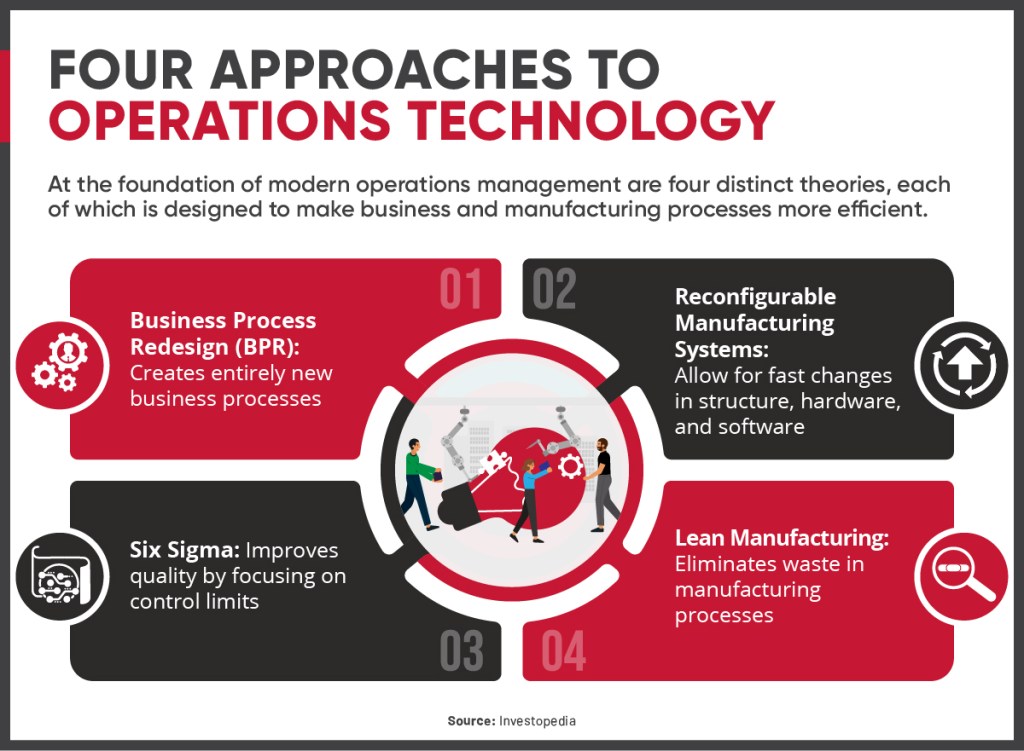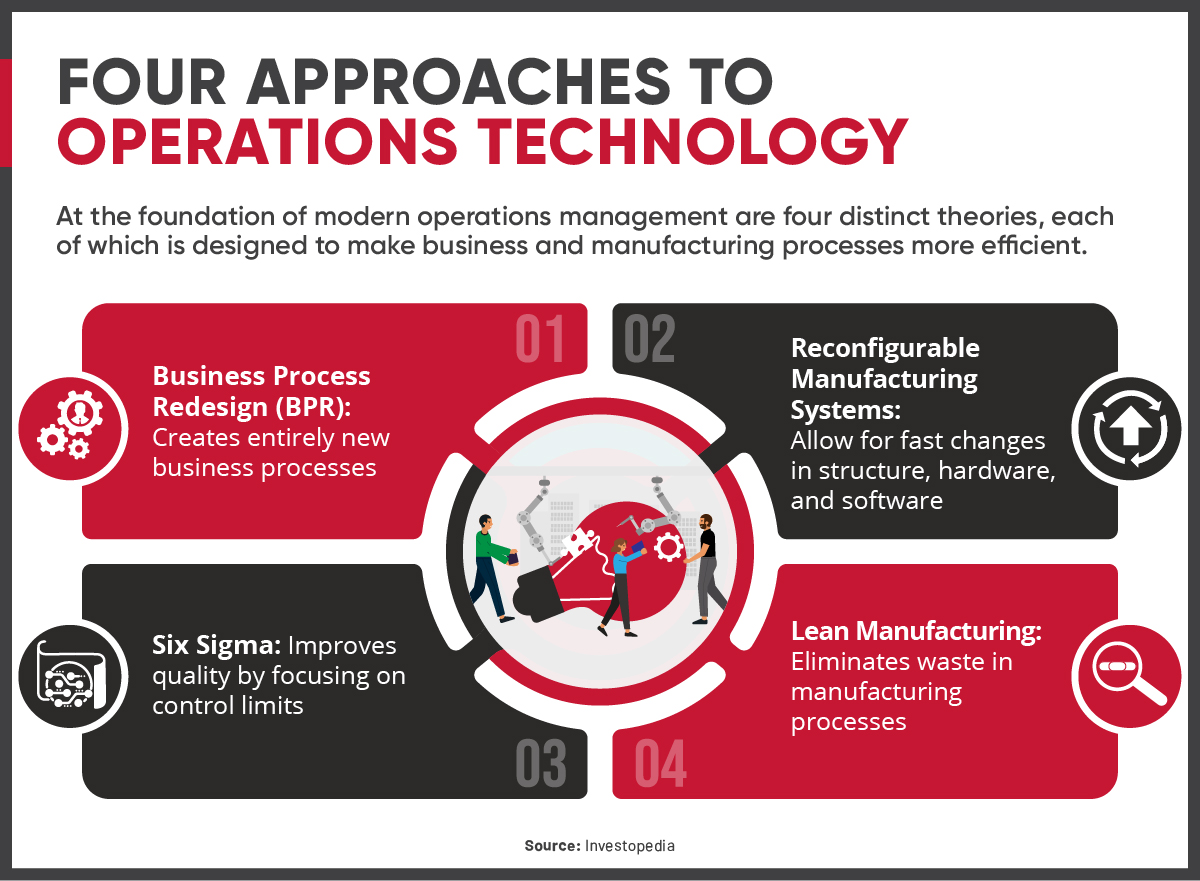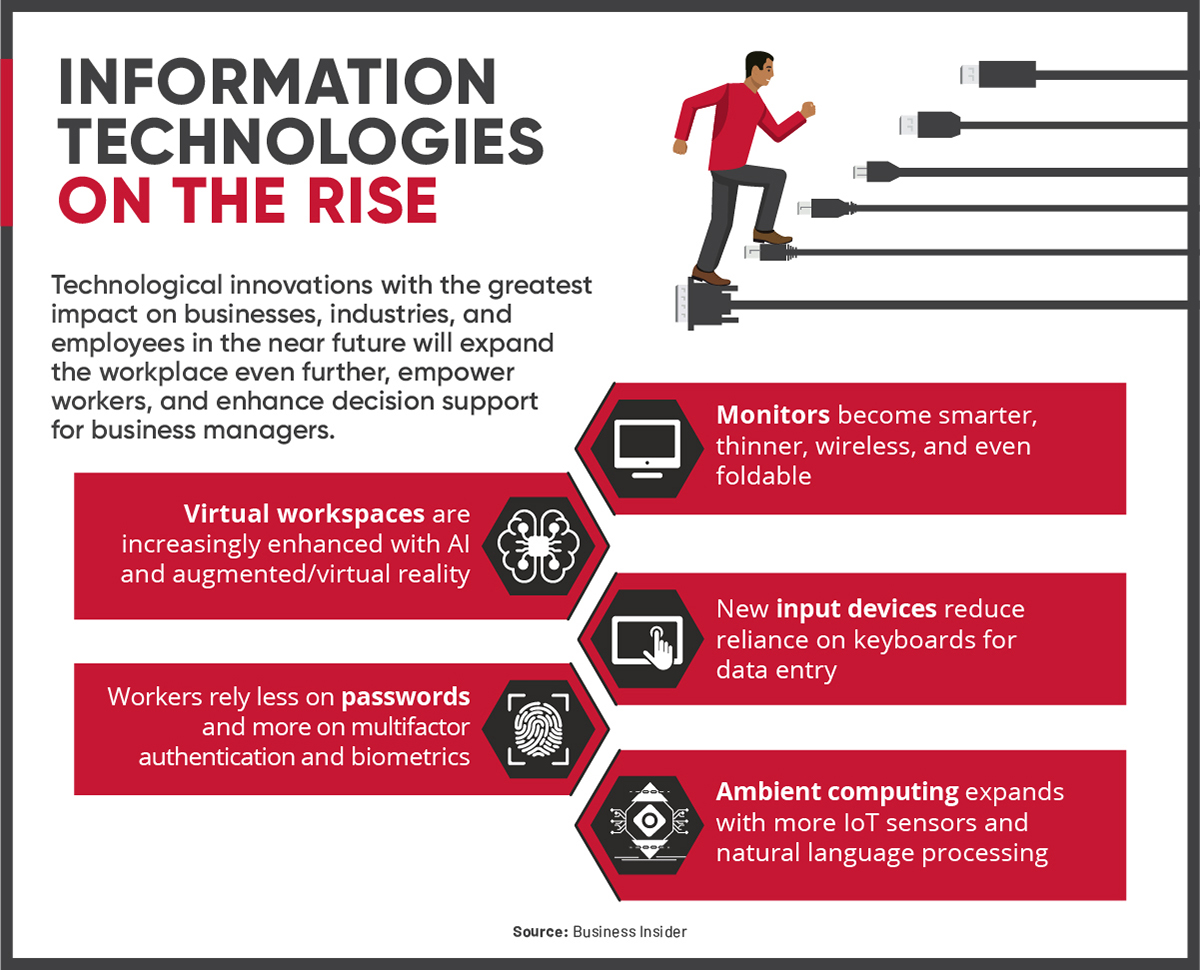IT vs. OT: Differences and Similarities

Technology has transformed nearly every aspect of our society — everyday communications, how and where we work, and the way products are made. In the digital age, developing and implementing technology has become a top priority for businesses of all sizes in the private, public, and nonprofit sectors.
For example, as of 2021, an estimated 90% of companies used some type of cloud service. This trend of maximizing technology is expected to continue for the foreseeable future across nearly every kind of organization and industry.
Today, interest in information technology (IT) and operational technology (OT) is growing. Both fields are helping businesses and industries improve efficiencies through the use of technology, and both offer workers greater job satisfaction and unprecedented flexibility in terms of remote work. Comparing IT vs. OT reveals many similar benefits; however, the terms aren’t entirely the same.
What Is OT?
While many people are familiar with the term information technology, or IT, they may still wonder what operational technology (OT) is. For decades, OT was less well known because it was limited in scope to the production and manufacturing of goods in specific industries, while IT was used more broadly. OT involves the use of proprietary software and hardware to manage and control mechanical, electronic, and other devices in the physical world.
Some examples of integral OT systems are industrial control systems, fire control systems, and building management systems. OT systems are especially useful in the following industries:
- Public utility plants (power, wastewater, etc.)
- Oil and gas
- Military
- Agriculture
- Healthcare
- Hospitality
In general, the OT systems in these industries must run 24/7, as interruptions would have serious consequences for the production of critically needed goods (for example, oil and gas) and the provision of utilities, such as wastewater treatment and the HVAC system in an office building.
OT may be broken down into key systems that include:
- Programmable logic controllers (PLCs)
- Supervisory control and data acquisition (SCADA) systems
- Industrial control systems (ICSs)
- Distributed control systems (DCSs)
One common type of hardware used for industrial automation is programmable logic controllers (PLCs). PLCs follow a set of rules and logic to perform a preprogrammed task or process. Some only handle a single-unit operation, while others can automate an entire production line. Some examples of PLCs are on/off switches, sensors, and float switches. One place where PLCs are found is inside municipal waste plants.
Complementary to PLC hardware, supervisory control and data acquisition (SCADA) systems are the software enabling automation in industrial processes. SCADA has the ability to connect a remote server with sensors that monitor motors, pumps, and other industrial equipment.
The real-time data gathered by SCADA allows managers to control equipment from remote locations. SCADA is commonly found at manufacturing plants, wastewater treatment plants, and oil and gas refineries, among other industries.
Industrial control systems (ICSs) are digital devices used in industrial processes. Both PLCs and SCADA are classified as ICSs.
Distributed control systems (DCSs) — also part of the ICS family — refer to the computerized systems of sensors and controllers used to manage operations within an industrial plant. They’re common in the petrochemical industry and municipal wastewater management.
DCSs are closely related to PLCs; historically, PLCs were capable of handling a limited number of controllers but are becoming more sophisticated. They may one day be able to handle thousands of interacting control loops like DCSs.
ICS and DCS are useful systems in OT to make operations more efficient. Additionally, there are four recognized theories of modern operations management further improve the efficiency of business and manufacturing processes: business process redesign (BPR), reconfigurable manufacturing systems, Six Sigma, and lean manufacturing practices.

At the foundation of modern operations management are four distinct theories, according to Investopedia. Each one is designed to make business and manufacturing processes more efficient and profitable. 1. Business process redesign (BPR) creates entirely new business processes. 2. Reconfigurable manufacturing systems allow for fast changes in structure, hardware, and software. 3. Six Sigma improves quality by focusing on control limits. 4. Lean manufacturing eliminates waste in manufacturing processes.
What Is IT?
Information technology (IT) refers to the management and control of computers, networks, and other equipment, along with supporting infrastructure, that are used to create, transmit, process, secure, and store electronic data. The protection and processing of this data is made possible through the use of business applications, TCP/IP (Transmission Control Protocol/Internet Protocol), and common operating systems.
Some of the top IT applications include the following:
- Cloud computing
- Mobile applications
- Data analytics
- Virtual and augmented reality
- Cybersecurity
- Blockchain
- Internet of Things (IoT)
- Edge computing
Today, there is a great deal of standardization and uniformity across the IT industry due to TCP/IP, which allows computers to communicate over the public internet or private networks (intranet or extranet), and operating systems such as Windows, iOS and macOS, and Linux.
IT is embedded in nearly every major industry around the globe. Some of the top industries where IT is used include the following:
- Healthcare: For the real-time sharing of patient information among care teams, which can lead to better patient outcomes. This may include monitoring patients’ conditions through wearable tech devices, such as digital blood pressure monitors and pedometers, so they can make informed treatment decisions with guidance from their providers.
- Corporate businesses: To replace manual processes for tracking inventory and save time on key functions such as accounting.
- Government: To protect confidential records and make them accessible online and to better connect both rural and urban communities with a strong technological infrastructure.
- Entrepreneurs: To launch businesses online via e-commerce sites or to market products or services through digital marketing channels.
What Are the Benefits of OT?
Operational technology (OT) is the use of hardware, software, and firmware to control industrial equipment and production processes. The key benefit of OT is the protection of manufacturing and industrial processes through the direct control and monitoring of physical devices and systems. OT facilitates critically needed equipment and processes that must run 24/7, such as energy, healthcare, and heating/cooling systems.
Several other benefits of modern OT include:
- Increased effectiveness of equipment
- Less downtime for production systems
- Greater worker productivity, as processes are controlled remotely
- The rise of autonomous “smart” factories
- Mass personalization: mass production of custom products for consumers and businesses
- Machine learning and artificial intelligence (AI) applied to inventory control, equipment maintenance, and manufacturing process management
Today, the ongoing digital transformation of OT has caused many of the functions of OT and IT to merge, which creates a great deal of overlap in IT vs. OT operations. However, in the past, this overlap wasn’t always the case.
OT systems existed long before the digital age, and workers once had to manually operate equipment or supervise programming in person. Traditionally, OT systems were not networked technology and did not take malware. Instead, OT systems communicated with a single production line inside a unique industry with specific needs.
Since the advent of the digital age, the work environment has evolved, and manufacturing industries have come to appreciate the benefits of controlling operations remotely. Thus, OT devices are increasingly more connected to IT networks and solutions.
The main drawback of the merger of OT and IT is cybersecurity, which becomes a growing concern for critical OT infrastructure that historically wasn’t exposed to such a risk. Another concern about the merger is the availability of skilled workers within OT operations to implement and manage new technology.

Rapid technological advancements have made change a constant in information and operations management. New technologies are leading to the merger of IT and OT functions in the following ways, according to CIO and Logic20/20: IT and OT leaders need change-management skills. Corporate cultures focus on flexibility and agility. Employees need support and tools for managing change. Remote work requires managers whom employees trust. All organizational initiatives are data-driven. Communications emphasize conversation over instruction. Losses resulting from change will happen. Successfully implementing change requires transparency. Small, gradual changes can have a greater, lasting impact. Metrics are mandatory for measuring progress.
OT has clearly benefited from the merger with IT in many ways, but challenges still lie ahead.
OT Benefits Resources
Managers, employees, and job seekers interested in learning about the benefits of OT can turn to several online resources delving into the topic.
- Red Hat is the world’s leading provider of enterprise open source solutions. It points out that as technologies are developed and IT and OT converge, industrial manufacturing can reap a number of benefits, including everything from improved production quality to increasing the output of personalized goods.
- NIST is a non-regulatory agency of the U.S. Department of Commerce that issued a publication on OT security, as well as its performance and reliability requirements.
- com is a leading developer of data encryption and privacy enhancing applications. The software giant’s blog points out one of the key benefits of digital transformation for businesses: lower operational costs.
What Are the Benefits of IT?
Information technology (IT) encompasses the hardware, software, and infrastructure required to facilitate data sharing and protect information. New trends are emerging all the time, and technology promises to become an even more significant fixture in our work lives in the future.
The applications of IT are widespread because, unlike traditional OT, IT has never been industry specific. A broad range of industries and organizations — private, public, and nonprofit — take advantage daily of the many benefits of IT, including:
- Virtual workplaces to offer greater flexibility to employees and lower operational costs
- Proactive cybersecurity to identify security weaknesses and prevent cyberattacks
- Predictive analytics to enhance decision support and risk management
- Intelligent customer relationship management systems to better analyze customer data
- No-code/low-code platforms for software development to save time and money on the creation of complex business applications
Beyond these benefits, the IT industry faces many new and ongoing challenges, including cybersecurity risks, limited budgets for digital transformation, the availability of skilled job candidates, and remote work.
IT Benefits Resources
Businesses, industries, and individuals interested in learning more about the benefits of IT can explore some of the several online resources available on this subject.
- Deloitte issued a research report, “2022 Technology Industry Outlook,” covering the state of the industry as a whole, including how and why companies must embrace cloud and service-based IT, hybrid work, and more.
- KPMG is a multinational professional services network whose blog highlights specific IT expected to benefit organizations, including everything from cloud strategies and quantum computing to artificial intelligence and even low-code/no-code technology.
- Gartner, an S&P 500 company specializing in technological research and consulting, outlines 12 technology trends expected to transform the industry in 2022, including cloud-native platforms, hyperautomation, and AI engineering.
Top OT Careers to Pursue
For those interested in helping manufacturers and industries run more smoothly, operations technology could be the right career track. As new technologies emerge, businesses will find opportunities to embrace technology to improve operational efficiencies.
Given the merger of IT and OT, project management, human factors engineering, and security are among the many skills that will be beneficial to anyone seeking a job in OT.
When thinking about pursuing an OT career, these are some of the most common job titles across the field, from leadership to entry-level roles:
- Chief operations officer
- Vice president of operations
- Director of operations
- Operations manager
- Operations coordinator
- Continuous improvement consultant
- Operations analyst
- Logistician
- Senior process engineer
- Operations tech
- Operations assistant
- Operations management trainee
By looking into salary data, job seekers can get an even better sense of a career in the OT industry. For example, the median annual salary for an operations manager position was about $68,000 as of July 2022, according to Payscale. However, the exact amount could vary slightly based on specific geographic location.
OT Career Resources
For job seekers who want to learn more about the highest-paying and most in-demand jobs within OT, many online resources offer helpful career planning information.
- Job\Searcher is a leading online job board that details an array of entry-, mid-, and senior-level operations jobs and indicates their hierarchy in a typical organizational chart.
- Payscale culls and averages salary data based on individual job titles such as director of operations. This data can help aspiring professionals map out their OT careers.
- Forecast, an AI-native platform for project management, outlines how optimizing technology and internal processes can improve operational efficiencies in the 21st century.
Careers in IT
Careers in IT are appealing because information technology is one of the world’s fastest-growing sectors. Some categories within IT are expected to grow at four to five times the current rate by 2030.
For those interested in helping businesses share and manage data, IT could be a promising career track. Employers in the private, public, and nonprofits sectors will always require skilled individuals to learn and maintain existing technologies and implement new ones.
Other encouraging news is that after learning TCP/IP or a common operating system (Windows, iOS and macOS, or Linux) in one business sector, that knowledge can often apply to a network in a different sector. This means job seekers with the right training and experience can often advance their careers in IT by easily moving to another company that uses the same software and hardware.
Beyond training and technical know-how, the following set of skills and traits will benefit virtually any IT career:
- Communication skills
- Analytical thinking
- Problem-solving
Information technology leadership includes higher-level positions that often require management skills coupled with crisis management and, of course, extensive experience in the technology industry. These roles can be more visionary in nature, such as planning for the future of an organization in pursuit of its IT goals.
Education and valuable IT industry certifications make it possible to initiate or advance an IT career. Job titles most frequently seen within the IT industry, from leadership to entry-level roles, include the following:
- Chief information officer/chief technology officer
- Director of technology
- Software engineering manager
- Big data engineers
- Cloud engineer/cloud architect/cloud consultant
- Software developer
- Information security specialist
- Information technology analyst
- IT project manager
- IT manager
- Database administrator
- Computer programmer
- Web developer
- IT assistant
- Computer support specialist

Technological innovations will expand the workplace, empower workers, and enhance decision support for business managers. New digital tools are expected to have the greatest impact on businesses, industries, and employees in the near future in the following ways, according to Business Insider: Virtual workspaces are increasingly enhanced with AI and augmented/virtual reality. Workers rely less on passwords and more on multifactor authentication and biometrics. Monitors become smarter, thinner, wireless, and even foldable. New input devices reduce reliance on keyboards for data entry. Ambient computing expands with more IoT sensors and natural language processing.
Anyone considering a career in IT should understand the impact technological innovations are expected to have on the workplace and IT industry job prospects. For example, the median annual salary for a computer programmer role was $93,000 in 2021, according to the U.S. Bureau of Labor Statistics.
IT Career Resources
Students and job seekers will benefit from the many online resources offering helpful insight into specific IT careers worth pursuing and how to present technology skills on a resume.
- Indeed is a leading online job search site with a career guide highlighting job titles available to those with IT degrees.
- The S. Department of Labor offers insight into the employment outlook for technology careers by outlining the top nine in-demand IT job titles to consider.
- The Balance Careers, a popular career planning resource site, offers job seekers advice on how to highlight technology skills on a resume.
IT vs. OT: Convergence and Opportunities
Comparing IT vs. OT reveals many differences, but the two concepts are increasingly interconnected. With the ongoing digital transformation of businesses and industries, traditional IT and OT operations are converging based on workflows, software, and hardware. Businesses and industries everywhere are enjoying the benefits of IT and OT, including enhanced operational efficiency and, ultimately, greater profitability.
Job seekers, students, and tech watchers alike will be interested in the diverse careers being created as a result of the merger of IT and OT. These vital new positions will require qualified workers with the right training, experience, and skill sets to develop, implement, maintain, and manage the risks associated with new technologies in organizations of all types and sizes.
Infographic Sources:
Business Insider, “10 Technology Trends That Will Shape the Hybrid Reality in 2022 and Beyond”
CIO, “10 Hard Truths of Change Management”

